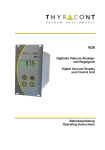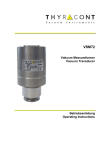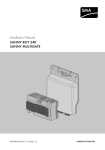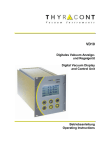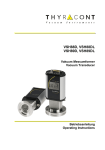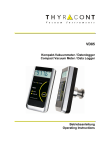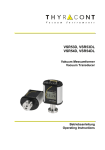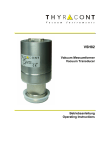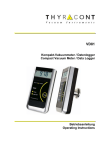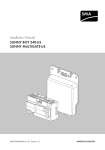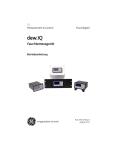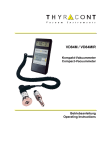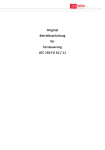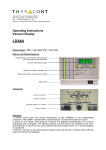Download Digitales Anzeige- und Regelgerät Digital Display and
Transcript
VD6 Digitales Anzeige- und Regelgerät Digital Display and Control Unit Betriebsanleitung Operating Instructions 2 Inhalt 1 2 3 4 5 6 7 Hinweise für Ihre Sicherheit .......................................................... 3 Das Anzeige- und Regelgerät VD6 ............................................... 4 2.1 Zur Orientierung ......................................................................... 4 2.2 Lieferumfang............................................................................... 4 2.3 Produktbeschreibung ................................................................. 4 Installation ...................................................................................... 6 3.1 Hinweise zur Installation............................................................. 6 3.2 Schalttafeleinbau ........................................................................ 7 3.3 Netzanschluss ............................................................................ 7 3.4 Anschluss Vakuum-Transmitter ................................................. 8 3.5 USB Anschluss ........................................................................... 8 3.6 Relais-Ausgänge ........................................................................ 9 3.7 Schreiberausgang .................................................................... 10 Betrieb ........................................................................................... 11 4.1 Inbetriebnahme ........................................................................ 11 4.2 Absolutdruckanzeige ................................................................ 11 4.3 Schaltpunkte ............................................................................. 12 4.4 Regelung starten und stoppen ................................................. 15 4.5 Gasartkorrektur ........................................................................ 15 4.6 Kommunikationsprotokoll ......................................................... 16 4.7 Befehlsübersicht ....................................................................... 16 Konfiguration ................................................................................ 18 5.1 Transmitter Typ ........................................................................ 18 5.2 Schaltverhalten ......................................................................... 19 5.3 Analogausgang ........................................................................ 20 5.4 Startmodus ............................................................................... 22 Wartung und Service ................................................................... 23 Technische Daten ........................................................................ 25 Konformitätserklärung ......................................................................... 26 Hersteller: Thyracont Vacuum Instruments GmbH Max Emanuel Straße 10 D 94036 Passau Tel.: +49/851/95986-0 Fax.: +49/851/95986-40 email: [email protected] Internet: http://www.thyracont.com 3 1 Hinweise für Ihre Sicherheit Lesen und befolgen Sie alle Punkte dieser Anleitung Informieren Sie sich über Gefahren, die vom Gerät ausgehen und Gefahren, die von Ihrer Anlage ausgehen Beachten Sie die Sicherheits- und Unfall-Verhütungsvorschriften Prüfen Sie regelmäßig die Einhaltung aller Schutzmaßnahmen Installieren Sie das VD6 unter Einhaltung der entsprechenden Umgebungsbedingungen; die Schutzart ist IP20, d.h. die Geräte sind geschützt gegen Eindringen von Fremdkörpern Beachten Sie beim Umgang mit den verwendeten Prozessmedien die einschlägigen Vorschriften und Schutzmaßnahmen Berücksichtigen Sie mögliche Reaktionen zwischen Werkstoffen und Prozessmedien Berücksichtigen Sie mögliche Reaktionen der Prozessmedien infolge der Eigenerwärmung des Produkts Gerät nicht eigenmächtig umbauen oder verändern Informieren Sie sich vor Aufnahme der Arbeiten über eine eventuelle Kontamination Beachten Sie im Umgang mit kontaminierten Teilen die einschlägigen Vorschriften und Schutzmaßnahmen Legen Sie beim Einsenden des Gerätes eine Kontaminationsbescheinigung bei Geben Sie die Sicherheitsvermerke an andere Benutzer weiter Piktogramm-Definitionen Gefahr eines elektrischen Schlages beim Berühren der Kontakte Gefahr von Personenschäden Gefahr von Schäden an Gerät oder Anlage Wichtige Information über das Produkt, dessen Handhabung oder den jeweiligen Teil der Betriebsanleitung, auf den besonders aufmerksam gemacht werden soll 4 2 Das Anzeige- und Regelgerät VD6 2.1 Zur Orientierung Diese Betriebsanleitung ist gültig für Produkte mit den Artikelnummern VD6S2115 und VD6S2230. Sie finden die Artikelnummern auf dem Typenschild. Technische Änderungen ohne vorherige Anzeige sind vorbehalten. 2.2 Lieferumfang Zum Lieferumfang gehören: VD6 Anzeige- und Regelgerät Gegenstecker für Netzbuchse und Schaltausgänge Gegenstecker für Schreiberausgang Befestigungsspangen zur Schalttafelmontage Betriebsanleitung Lieferbares Zubehör: Vakuum-Transmitter VSC42MA4, 1400 – 1 mbar -3 Vakuum-Transmitter VSP52MA4, 100 – 1,0 x 10 mbar Messkabel 2m, W0900002 Messkabel 6m, W0900006 USB Anschlusskabel 2m, WUSB0002 Windows-Software VacuGraph, VGR 2.3 Produktbeschreibung Das VD6 dient zum Anzeigen und Regeln von Absolutdruck. Anschließbar sind hierzu Thyracont Vakuum-Transmitter mit Signalausgang 4-20mA. Über die USB Schnittstelle des Geräts kann der Regler vom PC aus gesteuert werden. 5 1 2 3 4 5 6 7 8 9 10 1: LED Display 2: Druckeinheit 3: LED SP1: Schaltpunkt 1 bzw. oberer Schaltpunkt 4: LED: Sollwert bei 3-Punkt-Regelung 5: LED SP2: Schaltpunkt 2 bzw. unterer Schaltpunkt 6: LED: Regelung aktiv 7: Menu-Taste 8: Set-Taste 9: Aufwärts-Taste zum Einstellen von Werten 10: Abwärts-Taste zum Einstellen von Werten 11 12 13 14 15 11: Schreiberausgang 12: Anschluss Vakuum-Transmitter 13: USB Anschluss 14: Relais 1 für Schaltpunkt 1 15: Relais 2 für Schaltpunkt 2 16: Netzanschluss 16 6 Bestimmungsgemäße Verwendung Das VD6 dient in Verbindung mit Vakuum-Transmittern der Firma Thyracont zur Messung und Regelung von Absolutdruck. Es darf nur an geeignete und hierfür vorgesehene Komponenten angeschlossen werden. Nicht bestimmungsgemäße Verwendung Als nicht bestimmungsgemäß gilt der Einsatz zu Zwecken, die von oben genannten abweichen, insbesondere: der Anschluss an Geräte oder Komponenten, die laut ihrer Betriebsanleitung hierfür nicht vorgesehen sind der Anschluss an Geräte, die berührbare, spannungsführende Teile aufweisen. Bei nicht bestimmungsgemäßem Einsatz erlischt jeglicher Haftungs- und Gewährleistungsanspruch Die Verantwortung im Zusammenhang mit den verwendeten Prozessmedien liegt beim Betreiber. 3 Installation 3.1 Hinweise zur Installation Keine eigenmächtigen Umbauten oder Veränderungen am Gerät vornehmen! Vor dem Anschließen der Spannungsversorgung darauf achten, dass der auf dem Typenschild des VD6 angegebene Spannungsbereich mit der örtlichen Netzspannung übereinstimmt. Aufstellungsort: Innenräume Für nicht vollklimatisierte Betriebsräume gilt: Temperatur: +0°C ... +40°C Rel. Luftfeuchte: 5 - 85%, nicht betauend Luftdruck: 860 - 1060 hPa 7 3.2 Schalttafeleinbau Das Gerät ist zur Schalttafelmontage vorgesehen. Bei Verwendung als Tischgerät besteht die Gefahr eines elektrischen Schlages! Die Größe des benötigten Schalttafel-Ausbruchs beträgt 90 x 42 mm. Zur Schalttafelmontage sind die mitgelieferten Befestigungsspangen zu verwenden. Das Gerät in den Schalttafelausbruch einschieben und die Spangen -wie in der Abbildung unten gezeigt- in die seitlich am VD6-Gehäuse angebrachten Befestigungsknöpfe einhaken. Zur Fixierung die Schrauben von hinten anziehen, so dass das Gerät von hinten gegen die Schalttafel geklemmt wird. 3.3 Netzanschluss Kabel nur durch elektrotechnisch geschultes Personal herstellen oder anpassen lassen. Technische Daten beachten, um Überlastung oder Zerstörung des Geräts bzw. eine Gefahr für den Betreiber zu vermeiden. Die Netzspannung muss über einen geschalteten Netzverteiler zugeführt werden. Auf richtige Netzspannung achten, um Schäden am Gerät zu vermeiden! VD6S2115: 115 VAC, 50/60 Hz VD6S2230: 230 VAC, 50/60 Hz 8 3.4 Anschluss Vakuum-Transmitter Das Gerät muss sich im ausgeschalteten Zustand befinden, wenn Vakuum-Transmitter angeschlossen werden. Nichtbeachten dieser Anweisung kann zu Schäden am Gerät führen. An das Gerät kann ein Thyracont Vakuum-Transmitter für Absolutdruck angeschlossen werden. Zulässige Typen hierfür sind: VSC42MA4 (1400 – 1 mbar) -3 VSP52MA4 (100 – 1x10 mbar) Der Vakuum-Transmitter wird vom VD6 mit Strom versorgt. 1 2 3 4 5 6 7 8 9 SubD Pin 3: Pin 4: Pin 7: Pin 9: 3.5 USB Anschluss 9pol, weibl. Input: 4 -20 mA VSP52MA4 Input: 4 -20 mA VSC42MA4 Spannungsversorgung: 15 VDC, max. 1,5 W AGND (für 3-Leiter Anschluss) 9 1: 2: 3: 4: 5: Minibuchse Typ B VCC, +5V Data – Data + GND GND Der USB-Anschluss kann mit einem PC verbunden werden, um z.B. in TM Verbindung mit der Windows™ Software VacuGraph Druckwerte auszulesen, Messungen zu dokumentieren oder Sollwerte zu programmieren. 3.6 Relais-Ausgänge Zur externen Steuerung stehen an diesem Ausgang die Schaltfunktionen des VD6 in Form von 2 Wechsel-Relais Schaltpunkten SP1 und SP2 zur Verfügung (Darstellung in Ruhelage, stromlos, d.h. Schaltfunktion aus). Beigelegten Gegenstecker zum Verdrahten verwenden. Stecker nur in spannungsfreiem Zustand anschließen, anstecken oder abziehen. Ausgänge mit max. 2 A / 250 VAC, 1 A / 30 VDC (normal closed) bzw. 5 A / 250 VAC, 5 A / 30 VDC (normal open) ohmsch belastbar. 10 3.7 Schreiberausgang 1 2 1: 2: Klinkenbuchse Analog Out, 0-1V / 0-10V, min.10kΩ AGND Am Schreiberausgang steht der gemessene Absolutdruck als analoges Spannungssignal zur Verfügung. Der Spannungswert hängt je nach angeschlossenem Vakuum-Transmitter linear oder logarithmisch vom angezeigten Druck ab. Der Schreiberausgang kann dabei auf 0-1V oder 0-10V konfiguriert werden. Die Konfiguration sowie der Zusammenhang zwischen angezeigtem Druck und Ausgangsspannung sind in Abschnitt 5.3 beschrieben. Der Mindest-Lastwiderstand für den Schreiberausgang beträgt 10 kΩ. 11 4 Betrieb 4.1 Inbetriebnahme Zunächst ist der Vakuum-Transmitter entsprechend Abschnitt 3.4 ans VD6 anzuschließen. Sobald die Verbindung mit der Netzversorgung hergestellt ist, erscheinen folgende Anzeigen: - Displaytest (alle Segmente) Versionsnummer der Firmware Eingestellter Transmittertyp gemessener Absolutdruck. Das Gerät befindet sich nun im Messmodus. Falls der Regler –wie in Abschnitt 5.4 beschrieben- startaktiv konfiguriert wurde (Startmodus "run"), steuert das VD6 simultan mit der Anzeige des DruckIstwertes bereits die beiden Relais-Schaltausgänge. Ansonsten befinden sich die Relais Wechselschalter im Ruhezustand. Tastenbeschreibung: Umschaltung zwischen Messmodus und dem Einstellmodus f. Sollwert, Hysterese bzw. Gasart-Korrekturfaktor. set Messmodus: Start/Stop-Funktion für Regelung (s. auch Abschnitt 5.4) Einstellmodus: Bestätigung der eingestellten Werte Inkrementieren der Werte im Einstellmodus Dekrementieren der Werte im Einstellmodus 4.2 Absolutdruckanzeige Im Messmodus zeigt das Display den momentan gemessenen Absolutdruck. Die Druckanzeige erfolgt oberhalb 1 mbar (Torr...) numerisch, unterhalb in Exponentialdarstellung. Der Status der Schaltausgänge wird über die LEDs SP1 und SP2 angezeigt, wobei die jeweilige LED leuchtet, wenn das zugehörige Relais eingeschaltet ist. 12 4.3 Schaltpunkte Das VD6 kann –wie unter Abschnitt 5.2 beschrieben- als Zwei- oder DreipunktRegler konfiguriert werden. Schaltverhalten "2P" (2-Punkt-Regler) Die Relais-Schaltausgänge SP1 und SP2 werden jeweils mit Sollwert und zugehöriger Hysterese (H1 bzw. H2) eingestellt. Beide Schaltausgänge arbeiten voneinander unabhängig. Die Hysterese liegt jeweils symmetrisch um den Sollwert. Bei Änderung des Sollwertes wird die zugehörige Hysterese zunächst automatisch über einen prozentualen Zusammenhang an den neuen Sollwert adaptiert. Eine anschließende manuelle Änderung der Hysterese ist ebenfalls möglich (Werte werden dabei auf Plausibilität zum Sollwert überprüft). Beispiel: Sollwert 1 = 10mbar / H1=1mbar (10% vom Sollwert) Schaltausgang 1 wird bei 9mbar deaktiviert, bei 11mbar aktiviert. Änderung Sollwert 1 = 1.0mbar / H1=0.1mbar (automatisch !). Schaltausgang 1 wird bei 0.9mbar deaktiviert, bei 1.1mbar aktiviert. 13 Zum Einstellen der Schaltpunkte von SP1 (oder SP2): Taste Menu (mehrmals) drücken, bis rechts neben dem Display die LED für SP1 (bzw. SP2) leuchtet. Mithilfe der Pfeiltasten den gewünschten Sollwert einstellen. set Bestätigen mit der Set-Taste. Im Display erscheint die momentan eingestellte Hysterese. Mithilfe der Pfeiltasten die gewünschte Hysterese einstellen. Diese darf max. 90% des eingestellten Sollwertes betragen. set Bestätigen mit der Set-Taste. Erfolgt 5s lang kein Tastendruck oder wird eine Änderung mit der Taste "Menu" quittiert, werden die Änderungen verworfen und der ursprüngliche Zustand wieder angezeigt (Undo-Funktion). Schaltverhalten "3P" (3-Punkt-Regler) Die Schaltpunkte werden in Form eines gemeinsamen Sollwertes mit positiver Hysterese H1 für Evakuierung bzw. negativer Hysterese H2 für Belüftung eingestellt. Die Hysteresen können asymmetrisch zum Sollwert liegen. Bei Änderung des Sollwertes werden die Hysteresen zunächst automatisch über einen prozentualen Zusammenhang an den neu eingegebenen Sollwert adaptiert. Eine anschließende manuelle Änderung der Hysteresen ist ebenfalls möglich (Werte werden dabei auf Plausibilität zum Sollwert überprüft). Beispiel: Sollwert = 100mbar / Hysterese H1 = 10mbar, H2 = 20mbar Schaltausgang für Evakuierung SP1 wird bei 100mbar deaktiviert, bei 110mbar aktiviert. Schaltausgang für Belüftung SP2 wird bei 100mbar deaktiviert, bei 80mbar aktiviert. 14 Zum Einstellen der Schaltpunkte: Taste Menu (mehrmals) drücken, bis im Display die LED "Sollwert 3-PunktRegelung" leuchtet. Mithilfe der Pfeiltasten den gewünschten Sollwert einstellen. set Bestätigen mit der Set-Taste. Im Display erscheint die momentan eingestellte Hysterese H1 für Evakuierung. Mithilfe der Pfeiltasten Hysterese H1 einstellen, diese darf max. 90% des eingestellten Sollwertes betragen. set Bestätigen mit der Set-Taste. Im Display erscheint die momentan eingestellte Hysterese H2 für Belüftung. Mithilfe der Pfeiltasten Hysterese H2 einstellen, diese darf max. 90% des eingestellten Sollwertes betragen. set Bestätigen mit der Set-Taste. 15 Erfolgt 5s lang kein Tastendruck oder wird eine Änderung mit der Taste "Menu" quittiert, werden die Änderungen verworfen und der ursprüngliche Zustand wieder angezeigt (Undo-Funktion). 4.4 Regelung starten und stoppen Wird im Display des VD6 der momentan gemessene Absolutdruck angezeigt (Messmodus), so kann mit der "set"-Taste die Regelung gestartet und gestoppt werden: set Regelung eingeschaltet. Aktive Schaltausgänge werden durch LEDs angezeigt. set Regelung aus. 4.5 Gasartkorrektur Bei Totaldruck-Transmittern, die ein gasartabhängiges Messprinzip verwenden, kann zur Anpassung der Druckanzeige ein Gasart-Korrekturfaktor eingegeben werden. Dadurch wird in weiten Bereichen wieder eine korrekte Druckanzeige erzielt. Der Wert des einzustellenden Faktors ist der Betriebsanleitung des verwendeten Transmitters oder geeigneter Fachliteratur zu entnehmen. Der Wertebereich des Korrekturfaktors reicht von 0,20 bis 8,00. Zum Einstellen des Gasart-Korrekturfaktors: Taste Menu (mehrmals) drücken, bis im Display der Gasart-Korrekturfaktor "c..." erscheint. Per Pfeiltasten den gewünschten Korrekturfaktor einstellen. set Bestätigen mit der Set-Taste. Erfolgt 5s lang kein Tastendruck oder wird eine Änderung mit der Taste "Menu" quittiert, werden die Änderungen verworfen und der ursprüngliche Zustand wieder angezeigt (Undo-Funktion). 16 4.6 Kommunikationsprotokoll Wird die rückseitige Mini USB-Buchse des VD6 durch ein geeignetes Schnittstellen-Kabel (Zubehör WUSB0002) mit einem PC verbunden, so kann z.B. mittels TM VacuGraph Software (Zubehör VGR) der Regler vom PC aus via Virtual-ComPort Protokoll gesteuert werden. Die Kommunikation erfolgt gemäß Thyracont-Protokoll. Die Befehle werden in folgendem Rahmen als Zeichenfolge im ASCII-Code übertragen: Adresse Adresse: Code: Data: cks: CR: Data Code cks CR 3 Bytes, dezimal; RS232, USB: 001 1 Byte, Befehlsparameter, Großbuchstaben für Lesen, Kleinbuchstaben für Schreiben Datenfeld, max. 6 Bytes; kann je nach Code auch fehlen 1 Byte, Checksumme, definiert als Summe über alle Bytes der Felder Adresse, Code und Data, modulo 64 plus 64. Carriage Return (0Dh, 13d) Datenformat: FLOAT: 6 Bytes, Exponentialformat 4 Bytes Mantisse (entspricht Mantissenwert x 1000) 2 Bytes Exponent, Offset 20 FLOAT-Werte werden in hPa (mbar) übertragen! -1 Beispiel: Der Wert "460019" in einem Float-Datenfeld steht für 4.6x10 mbar. 4.7 Befehlsübersicht Über die USB Schnittstelle des VD6 sind folgende Funktionen verfügbar: Befehlstyp Code Datentyp Funktion Gerätetyp Messwert Schaltpunkt T M S, s STRING FLOAT FLOAT Hysterese H, h FLOAT Gasart-Korrekturfaktor Regelung start/stop Tastaturverriegelung C, c A, a K, k UNSIGNED INT BOOLEAN BOOLEAN lesen lesen lesen S, schreiben s (SP1 und SP2) lesen H, schreiben h (H1 und H2) lesen C, schreiben c lesen A, schreiben a lesen K, schreiben k 17 Beispiele: Aktion Telegramm an VD6 Messwert lesen "001M^ R" Regelung starten Schaltpunkt 2 lesen "001a1c R" C "001S2V R" Unlock Schaltpunkt 2 "001s2v R" Schaltpunkt 2 auf 4.2x10-2 mbar setzen Unlock Gasart-Korrekturfaktor 1 "001s420018s R" Gasart-Korrekturfaktor 1 auf 1.20 setzen "001c000120W R" C C C C C Antwort-Telegramm vom VD6 C "001M864022T R" ( 8.64x10+2mbar = 864 mbar) C "001a1c R" C "001S400018Q R" ( 4.0x10-2 mbar) C "001s2v R" C "001s420018s R" C "001c1e R" "001c1e R" C C "001c000120W R" Vor dem Schreiben der Parameter "s" (Schaltpunkt), "h" (Hysterese) und "c" (Korrekturfaktor) müssen diese zunächst mit einem Unlock-Befehl freigeschaltet werden! Für weitere Informationen beachten Sie bitte die gesonderte Beschreibung des Thyracont-Kommunikationsprotokolls. 18 5 Konfiguration Änderungen der Geräte-Konfiguration nur von geschultem Fachpersonal durchführen lassen! Um im Konfigurationsmodus Grundeinstellungen des VD6 zu ändern: beim Einschalten des Gerätes die "set"-Taste gedrückt halten, bis die Anzeige "typ .." erscheint. set 5s 5.1 Transmitter Typ Das VD6 kann für den Betrieb mit folgenden Vakuum-Transmittern konfiguriert werden: Typ1: Typ3: VSC42MA4, 1400-1 mbar -3 VSP52MA4, 100-1x10 mbar Zum Einstellen des Transmittertyps das VD6 wie unter Abschnitt 5 beschrieben in den Konfigurationsmodus schalten, so dass die Anzeige "typ .." erscheint. Der momentan eingestellte Transmittertyp wird angezeigt. Mithilfe der Pfeiltasten kann nun zwischen den verschiedenen Typen gewechselt werden. set Die Auswahl mit der Set-Taste bestätigen. Im Display erscheint der nächste Konfigurationspunkt. Um zum Messmodus zurückzukehren, alle weiteren Konfigurationspunkte mithilfe der "Menu" Taste überspringen. 19 5.2 Schaltverhalten Zweipunktregelung "2P": Die beiden Schaltausgänge arbeiten unabhängig mit jeweils einstellbarem Sollwert und symmetrischer Hysterese. Dreipunktregelung "3P": Die beiden Schaltausgänge arbeiten als Evakuierungs- bzw. Belüftungskontakt. Einstellbar sind ein gemeinsamer Sollwert und jeweils eine asymmetrische Hysterese (Schaltpunktabstand). Zum Einstellen des Schaltverhaltens das VD6 wie unter Abschnitt 5 beschrieben in den Konfigurationsmodus schalten, so dass die Anzeige "typ .." erscheint. Taste Menu (mehrmals) drücken, bis im Display die Anzeige des momentan gewählten Schaltverhaltens erscheint. Mithilfe der Pfeiltasten kann nun zwischen den Modi "2P" und "3P" gewechselt werden. set Die Auswahl mit der Set-Taste bestätigen. Im Display erscheint der nächste Konfigurationspunkt. Um zum Messmodus zurückzukehren, alle weiteren Konfigurationspunkte mithilfe der "Menu" Taste überspringen. 20 5.3 Analogausgang Das Analogsignal des VD6 Schreiberausgangs (siehe Abschnitt 3.6) kann auf 0-1V oder 0-10V konfiguriert werden. Einstellung 0 – 1.0 V: VD6 mit Vakuum-Transmitter Typ1 / VSC42MA4: 0 – 1 V, linear; 0,282 V entspricht 1 mbar; 1,408 V entspricht 1400 mbar VD6 mit Vakuum-Transmitter Typ3 / VSP52MA4: 0 – 1,0 V, nichtlinear gemäß Kennlinie (siehe unten) 0,200 V entspricht 0,001 mbar; 1,000 V entspricht 1000 mbar Druck (mbar) 0,001 0,002 0,004 0,006 0,008 0,010 0,020 0,040 0,060 0,080 0,10 0,20 0,40 0,60 Output (mV) 200 203,4 208,4 213,5 217,7 221,9 239,6 270,7 296,0 317,1 335,6 403,8 498,9 562,9 Druck (mbar) 0,80 1,0 2,0 4,0 6,0 8,0 10 20 40 60 80 100 1000 Output (mV) 610,1 647,2 755,8 849,3 892,2 914,9 930,9 963,8 981,5 986,5 990,7 992,4 1000 Einstellung 0 – 10 V: VD6 mit Transmitter Typ1 / VSC42MA4: 0 – 10 V, linear; 5 mV / mbar VD6 mit Transmitter Typ3 / VSP52MA4: 0 – 10 V, logarithmisch; (1V pro Dekade) -3 2,5 V entspricht 1x10 mbar; 8,5 V entspricht 1000 mbar Vout (V) = 0,005 p(mbar) p (mbar) = Vout (V) / 0,005 Vout (V) = log (p(mbar)) + 5.5 p (mbar) = 10 (Vout(V) - 5.5) 21 Zum Konfigurieren des Analogausgangs das VD6 wie unter Abschnitt 5 beschrieben in den Konfigurationsmodus schalten, so dass die Anzeige "typ .." erscheint. Taste Menu (mehrmals) drücken, bis im Display "Pout" zur Konfiguration des Analogausgangs erscheint. set Set-Taste Menu drücken, die momentan gewählte Konfiguration des Analogausgangs erscheint. Mithilfe der Pfeiltasten kann nun zwischen den Einstellungen "1" und "10" gewechselt werden. set Die Auswahl mit der Set-Taste bestätigen. Im Display erscheint der nächste Konfigurationspunkt. Um zum Messmodus zurückzukehren, alle weiteren Konfigurationspunkte mithilfe der "Menu" Taste überspringen. 22 5.4 Startmodus Unter diesem Konfigurationspunkt kann eingestellt werden, wie sich der Regler beim Einschalten der Spannungsversorgung verhalten soll: Stop: run: Die Regelung ist beim Einschalten des Gerätes zunächst inaktiv und kann mit der Taste "set" gestartet und wieder gestoppt werden. Die Regelung ist beim Einschalten des Gerätes automatisch eingeschaltet. Sie kann nicht per Tastendruck gestartet oder gestoppt werden! Ein Starten oder Stoppen der Regelung per Softwarebefehl über USB ist unabhängig von den hier gemachten Einstellungen in jedem Falle möglich. Zum Ändern des Startmodus das VD6 wie unter Abschnitt 5 beschrieben in den Konfigurationsmodus schalten, so dass die Anzeige "typ .." erscheint. Taste Menu (mehrmals) drücken, bis im Display die momentan gewählte StartKonfiguration erscheint. Mithilfe der Pfeiltasten kann nun zwischen den Einstellungen "Stop " und "run" gewählt werden. set Die Auswahl mit der Set-Taste bestätigen. Das VD6 wird neugestartet und schaltet in den Messmodus. 23 6 Wartung und Service Vorsicht bei kontaminierten Teilen! Es kann zu Gesundheitsschäden kommen. Informieren Sie sich vor Aufnahme der Arbeiten über eine eventuelle Kontamination. Beachten Sie beim Umgang mit kontaminierten Teilen die einschlägigen Vorschriften und Schutzmaßnahmen. Das Gerät ist wartungsfrei. Äußerliche Verschmutzungen können mit einem feuchten Tuch beseitigt werden. Sollte wider Erwarten ein Schaden an Ihrem VD6 auftreten, senden Sie das Gerät bitte mit einer Kontaminationserklärung zur Reparatur an uns. Das Gerät ist nicht zur kundenseitigen Reparatur vorgesehen! Fehlermeldungen Anzeige Mögliche Ursache "ur" Messbereich unterschritten "or" Messbereich überschritten "Err1" Vakuum-Transmitter nicht angeschlossen Steckverbindungen und Leitung überprüfen Falscher Gerätetyp eingestellt Richtigen Gerätetyp einstellen (Kapitel 5.1) Vakuum-Transmitter defekt Vakuum-Transmitter zur Reparatur einschicken VD6 einschicken "Err4" Speicher Lesefehler Behebung 24 25 7 Technische Daten Anzeige Anzeigerate LED 13mm; max. 4 ½ stellig Anzeigeeinheit mbar (Torr auf Anfrage) 2 Hz (0,5s) Abtastrate 20 Hz (50 ms) Spannungsversorgung VD6S2230: 230 VAC, 50/60 Hz VD6S2115: 115 VAC, 50/60 Hz max. 3,5 W Leistungsaufnahme Sicherung Betriebstemperatur VD6S2230: 100 mA/T VD6S2115: 200 mA/T 5...50 oC Lagertemperatur -20...+60 oC Mess-Eingang 4-20 mA, SubD Buchse 9polig f. Transmitter VSC42MA4 oder VSP52MA4 Schaltausgänge Schreiberausgang 2 x Relaiskontakt, potentialfreie Wechsel-Schalter, jeweils Phoenix Klemmleiste 3polig: 2 A / 250 VAC, 1 A / 30 VDC (normal closed) 5 A / 250 VAC, 5 A / 30 VDC (normal open) 0-1 V bzw. 0-10 V Serielle Schnittstelle Mini USB Typ B, Virtual Com Port Protokoll Abmessungen 96 x 48 x 142 mm; Schalttafelausbruch: 90 x 42 mm Schutzart IP 20 Gewicht 410 g 26 Konformitätserklärung 27 Content 1 2 3 4 5 6 7 Safety Instructions ....................................................................... 28 The VD6 Display and Control Unit.............................................. 29 2.1 For Orientation ......................................................................... 29 2.2 Delivery Content ....................................................................... 29 2.3 Product Description .................................................................. 29 Installation .................................................................................... 31 3.1 Notes for Installation ................................................................ 31 3.2 Panel Installation ...................................................................... 32 3.3 Mains Connection..................................................................... 32 3.4 Transducer Connection ............................................................ 33 3.5 USB Connection ....................................................................... 33 3.6 Relay Outputs ........................................................................... 34 3.7 Recorder Output ....................................................................... 35 Operation ...................................................................................... 36 4.1 Startup ...................................................................................... 36 4.2 Measuring Absolute Pressure .................................................. 36 4.3 Switchpoints ............................................................................. 37 4.4 Start or Stop Control ................................................................ 40 4.5 Gas Correction Factors ............................................................ 40 4.6 Communication Protocol .......................................................... 41 4.7 Survey of Commands ............................................................... 41 Configuration................................................................................ 43 5.1 Transducer Type ...................................................................... 43 5.2 Switching Mode ........................................................................ 44 5.3 Recorder Output ....................................................................... 45 5.4 Start Mode ................................................................................ 47 Maintenance and Service ............................................................ 48 Technical Data .............................................................................. 50 Declaration of Conformity.................................................................... 51 Manufacturer: Thyracont Vacuum Instruments GmbH Max Emanuel Straße 10 D 94036 Passau Phone.: +49/851/95986-0 Fax.: +49/851/95986-40 email: [email protected] Internet: http://www.thyracont.com 28 1 Safety Instructions Read and follow the instructions of this manual Inform yourself regarding hazards, which can be caused by the product or arise in your system Comply with all safety instructions and regulations for accident prevention Check regularly that all safety requirements are being complied with Take account of ambient conditions when installing your VD6. The protection class is IP 20, which means the unit is protected against penetration of foreign bodies. Adhere to the applicable regulations and take the necessary precautions for the process media used Consider possible reactions between materials and process media Consider possible reactions of the process media due to the heat generated by the product Do not carry out any unauthorized conversions or modifications on the unit Before you start working, check whether any of the vacuum components are contaminated Adhere to the relevant regulations and take the necessary precautions when handling contaminated parts When returning the unit to us, please enclose a declaration of contamination Communicate the safety instructions to other users Pictogram-Definition Danger of an electric shock when touching Danger of personal injury Danger of damage to the unit or system Important information about the product, it's handling or about a particular part of the documentation, which requires special attention 29 2 The VD6 Display and Control Unit 2.1 For Orientation These operating instructions describe installation and operation of products with article numbers VD6S2115 and VD6S2230. The article number can be found on the product's type label. Technical modifications are reserved without prior notification. 2.2 Delivery Content Included in the delivery consignment are: VD6 display and control unit counterplugs for mains supply and relay outputs counterplug for recorder output mounting brackets for panel installation operating instructions Available accessories: Transducer VSC42MA4, 1400 – 1 mbar -3 Transducer VSP52MA4, 100 – 1,0 x 10 mbar Measuring cable 2m, W0900002 Measuring cable 6m, W0900006 USB cable 2m, WUSB0002 Windows-Software VacuGraph, VGR 2.3 Product Description The VD6 is designed to display and control absolute pressure. You can connect Thyracont vacuum transducers with 4-20mA signal output. Via USB interface the instrument you can be remote controlled by a PC. 30 1 2 3 4 5 6 7 8 9 10 1: LED display 2: Pressure dimension 3: LED SP1: setpoint 1 / upper switchpoint 4: LED: setpoint (for 3-state-control) 5: LED SP2: setpoint 2 / lower switchpoint 6: LED: control on 7: Menu-key 8: Set-key 9: Up-key for value adjustment 10: Down-key for value adjustment 11 12 13 14 15 11: Recorder output 12: Connector for transducer 13: USB interface 14: Relay 1 for switchpoint 1 15: Relay 2 for switchpoint 2 16: Mains connector 16 31 Proper Use The VD6 serves exclusively to display and control absolute pressure in combination with Thyracont vacuum transducers. It may only be connected to components specifically provided for such purpose. Improper Use The use for purposes not covered above is regarded as improper, in particular: the connection to components not allowed for in their operating instructions the connection to components containing touchable, voltage carrying parts. No liability or warranty will be accepted for claims arising from improper use. The user bears the responsibility with respect to the used process media. 3 Installation 3.1 Notes for Installation Unauthorized modifications or conversions of the instrument are not allowed! Before connecting to mains power: make sure that the supply voltage stated on the type label complies with your local mains voltage. Installation location: Indoor For not fully air conditioned open buildings and operation rooms: Temperature: +0°C ... +40°C Rel. Humidity: 5 - 85%, not condensing Air pressure: 860 - 1060 hPa 32 3.2 Panel Installation The instrument is designed for panel mounting. When used as desktop device there will be the danger of an electric shock! The size of the panel cavity needed is 90 x 42 mm. For installation please use the mounting brackets which came enclosed with the VD6. Insert the VD6 in the panel and hook the brackets into the mounting knobs at the sides of the instrument as shown below. To fix the unit tighten the screws so that the VD6 is clamped against the panel. 3.3 Mains Connection Cables may be manufactured or adapted by persons with suitable technical education only. Consider technical data to avoid overload or destruction of the instrument and danger for the user. Mains voltage must be supplied via terminal box. Make sure that you use the appropriate mains voltage in order to prevent the instrument from being damaged! VD6S2115: 115 VAC, 50/60 Hz VD6S2230: 230 VAC, 50/60 Hz 33 3.4 Transducer Connection The instrument must be switched off before any transducers are connected. Not following this instruction may lead to damage of the instrument. To the VD6 Thyracont transducers for absolute pressure can be connected. Admissible types are: VSC42MA4 (1400 – 1 mbar) , -3 VSP52MA4 (100 – 1x10 mbar) The VD6 provides voltage supply fort the transducer. 1 2 3 4 5 6 7 8 9 SubD Pin 3: Pin 4: Pin 7: Pin 9: 3.5 USB Connection 9pin, female. Input 4 -20 mA: VSP52MA4 Input 4 -20 mA: VSC42MA4 Voltage Supply: 15 VDC, max. 1,5W AGND (for 3-wire-connection) 34 1: 2: 3: 4: 5: Mini Socket Type B VCC, +5V Data – Data + GND GND The USB port can be connected to PC for reading measurements, process documentation or programming setpoints by means of the Windows-Software TM VacuGraph . 3.6 Relay Outputs For process control the VD6 provides 2 change-over relay switching outputs SP1 and SP2 (shown in rest position, currentless, i.e. switching function off). Use enclosed counter plug for electrical connection. Connect only when power is off. Maximum ohmic load for the relays is 2 A / 250 VAC, 1 A / 30 VDC (normal closed) or 5 A / 250 VAC, 5 A / 30 VDC (normal open) . 35 3.7 Recorder Output 1 2 1: 2: Jack Plug Analog Out, 0-1V / 0-10V,min.10kΩ AGND The recorder output provides an analog voltage signal corresponding to actual pressure. The voltage output has a linear or logarithmic characteristic depending on the connected transducer type. The recorder output can further be configured as 0-1 V or 0-10V signal. Minimum load resistor for the recorder output is 10 kΩ. 36 4 Operation 4.1 Startup First a transducer must be connected to the VD6 according to chapter 3.4. As soon as the mains power supply is connected, the display will show the following information: - display test (all segments) firmware version selected transducer type actual pressure. Then the instrument is in measurement mode. If the controller is configured start active - see chapter 5.4 (start mode "run") -, the VD6 will actuate the two relay outputs simultaneously with the display of actual pressure. Otherwise the change-over relays are in rest position. Key Description: Change between measurement mode and the adjustment of setpoints, hysteresis or gas correction factor. set Measurement mode: start/stop controlling (see also chapter 5.4) Adjustment mode: confirm settings Increment values in adjustment mode Decrement values in adjustment mode 4.2 Measuring Absolute Pressure In measurement mode the VD6 display shows the actual absolute pressure. Pressure reading is numerical above 1 mbar (Torr, …) and exponential below. The state of the switching outputs is indicated by LEDs SP1 and SP2, which are on as soon as the corresponding relay is switched on. 37 4.3 Switchpoints The VD6 can be configured as two- or three-state-controller as described in chapter 5.2. Switching Mode "2P" (2-state-control) The relay outputs SP1 and SP2 are each adjusted by a setpoint and a related hysteresis (H1 and H2). Both switching outputs work independently of each other. The hysteresis is set symmetrically around the setpoint. When the setpoint is changed the related hysteresis is automatically adjusted by means of a percentage relation. Afterwards the hysteresis can be manually adjusted (value is checked for plausibility with regard to the setpoint). Example: setpoint 1 = 10mbar / H1=1mbar (10% from setpoint) Switching output 1 is deactivated at 9mbar, activated at 11mbar. Change: setpoint 1 = 1.0mbar / H1=0.1mbar (automatically !). Switching output 1 is deactivated at 0.9mbar, activated at 1.1mbar. 38 In order to adjust the switchpoints SP1 (or SP2): Press the menu key (several times), until the LED for SP1 (SP2) is on. Adjust the setpoint by means of the "Up" and "Down" keys. set Confirm with "Set" key. The display shows the current hysteresis. Adjust the hysteresis by means of the "Up" and "Down" keys. The maximum permissible hysteresis is 90% of setpoint. set Confirm with "Set" key. If no key is pressed for 5s or if changes are quitted by the menu key, changes are discarded and the primary state is restored (undo function). Switching Mode "3P" (3-state-control) The switchpoints are set by a common setpoint with positive hysteresis H1 for evacuation and negative hysteresis H2 for venting. Hysteresis H1 and H2 can lie asymmetrically around the setpoint. When the setpoint is changed hysteresis H1 and H2 are automatically adjusted by means of a percentage relation. Afterwards the hysteresis can be manually adjusted (value is checked for plausibility with regard to the setpoint). Example: setpoint = 100mbar hysteresis H1 = 10mbar, H2 = 20mbar Switching output for evacuation SP1 is deactivated at 100mbar, activated at 110mbar. Switching output for venting SP2 is deactivated at 100mbar, activated at 80mbar. 39 In order to adjust the switchpoints: Press the menu key (several times), until the LED "setpoint 3-state-control" is on. Adjust the setpoint by means of the "Up" and "Down" keys. set Confirm with "Set" key. The display shows the current hysteresis H1 for evacuation. Adjust the hysteresis H1 by means of the "Up" and "Down" keys. The maximum permissible hysteresis is 90% of the setpoint. set Confirm with "Set" key. The display shows the current hysteresis H2 for venting. Adjust the hysteresis H2 by means of the "Up" and "Down" keys. The maximum permissible hysteresis is 90% of the setpoint. set Confirm with "Set" key. 40 If no key is pressed for 5s or if changes are quitted by the menu key, changes are discarded and the primary state is restored (undo function). 4.4 Start or Stop Control When the VD6 display shows the actual pressure reading (measurement mode), control can be started and stopped by means of the "set"-key: set Control on. Active switching outputs are indicated by the corresponding LEDs. set Control off. 4.5 Gas Correction Factors For vacuum transducers whose pressure reading depends on type and composition of the gas a correction factor can be entered into the VD9 in order to adjust the pressure reading. With this method a correct pressure reading is again achieved then over a wide range. The value for the gas correction factor can be found in the operation instructions of the transducer or in suitable technical literature. The range of the gas correction factor is 0,20 to 8,00. In order to adjust the gas correction factor: Press the menu key (several times), until the gas correction factor "c..." is shown in the display. Adjust the factor by means of the "Up" and "Down" keys. set Confirm with "Set" key. If no key is pressed for 5s or if changes are quitted by the menu key, changes are lost and the primary state is restored (undo function). 41 4.6 Communication Protocol When the Mini USB port at the back of the VD6 is connected to a PC by a suitable interface cable (accessory WUSB0002), the instrument can be remote TM controlled by the PC via Virtual-Com-Port protocol, e.g. using VacuGraph Software (accessory VGR). Communication is carried out according to the Thyracont protocol. The commands are sent as ASCII-code in the following command frame: Address Address: Code: Data: cks: CR: Code Data cks CR 3 Bytes, decimal; address RS232, USB: 001 1 Byte, command parameter, upper case character for read command, lower case character for write command data field, max. 6 Bytes; can be absent depending on code 1 Byte, checksum, defined as sum over all Bytes of the fields address, code and data, modulo 64 plus 64. Carriage Return (0Dh, 13d) Data Formats: BOOLEAN STRING: UNSIGNED INT: FLOAT: 1 Byte max. 6 Bytes 6 Bytes with leading zeros 6 Bytes, exponential format 4 Bytes mantissa (means mantissa value x 1000) 2 Bytes exponent, offset 20 FLOAT-values are transmitted in hPa (mbar)! -1 Example: Value "460019" in a float type data field means 4.6x10 mbar. 4.7 Survey of Commands By the serial interface of the VD6 the following functions are available: Command Type Measurement Value Setpoint Code T M S, s Data Type STRING FLOAT FLOAT Hysteresis H, h FLOAT Gas-Correction-Factor Control start/stop Keylock C, c A, a K, k UNSIGNED INT BOOLEAN BOOLEAN Function read read read S, write s (SP1 and SP2) read H, write h (H1 and H2) read C, write c read A, write a read K, write k 42 Examples: Action Telegram to VD6 Read pressure measurement "001M^ R" Start Control Read setpoint 2 "001a1c R" C "001S2V R" Unlock setpoint 2 "001s2v R" Set setpoint 2 to 4.2x10-2 mbar Unlock gas-correction-factor 1 "001s420018s R" Set gas-correction-factor 1 to 1.20 "001c000120W R" C C C C C Answer telegram from VD6 C "001M864022K R" (8.64x10+2mbar = 864 mbar) C "001a1c R" C "001S400018Q R" ( 4.0x10-2 mbar) C "001s2v R" C "001s420018s R" C "001c1e R" "001c1e R" C C "001c000120W R" Before writing the parameters "s" (setpoint), "c" (correction factor) and "h" (hysteresis) they must be activated by sending the related unlock command! For further information please refer to the separate description of the Thyracont communication protocol. 43 5 Configuration Changes of the instrument configuration should be carried out only by qualified personnel! In order to change settings of the VD6 in the configuration mode: Hold the "set"-key pressed when the VD6 is connected to mains supply until the display shows "typ ..". set 5s 5.1 Transducer Type The VD6 is configurable for operating the following vacuum transducers: Typ1: Typ3: VSC42MA4, 1400-1 mbar -3 VSP52MA4, 100-1x10 mbar To select the transducer type switch the VD6 into configuration mode as described in chapter 5, so that the display shows "typ ..". The currently selected transducer type is displayed. Select the required type by means of the "Up" and "Down" keys. set Confirm with "Set" key. The display then shows the next configuration point. In order to return to measurement mode quit all further configuration points by pressing the menu key. 44 5.2 Switching Mode 2-State-Control "2P": Both switching outputs work independently of each other, each with adjustable setpoint and symmetric hysteresis. 3-State-Control "3P": The two switching outputs operate as relays for evacuation and venting. A common setpoint with asymmetric hysteresis is adjustable. To select the switching mode put the VD6 into configuration mode as described in chapter 5, so that the display shows "typ ..". Press the menu key (several times) until the display shows the currently selected switching mode. You can now toggle between mode "2P" and "3P" by means of the "Up" and "Down" keys. set Confirm with "Set" key. The display then shows the next configuration point. In order to return to measurement mode quit all further configuration points by pressing the menu key. 45 5.3 Recorder Output The analog signal of the VD6 recorder output (see chapter 3.6) can be configured as 0-1V or 0-10V output. Setting 0 – 1.0 V: VD6 with transducer type 1 / VSC42MA4: 0 – 1 V, linear; 0.282 V corresponds to 1 mbar; 1.408 V corresponds to 1400 mbar VD6 with transducer type 3 / VSP52MA4: 0 – 1.0 V, nonlinear according to characteristic curve (see below) 0.200 V corresponds to 0.001 mbar; 1.000 V corresponds to 1000 mbar Pressure (mbar) 0.001 0.002 0.004 0.006 0.008 0.010 0.020 0.040 0.060 0.080 0.10 0.20 0.40 0.60 Output (mV) 200 203.4 208.4 213.5 217.7 221.9 239.6 270.7 296.0 317.1 335.6 403.8 498.9 562.9 Pressure (mbar) 0.80 1.0 2.0 4.0 6.0 8.0 10 20 40 60 80 100 1000 Output (mV) 610.1 647.2 755.8 849.3 892.2 914.9 930.9 963.8 981.5 986.5 990.7 992.4 1000 Setting 0 – 10 V: VD6 with transducer type 1/ VSC42MA4: 0 – 10 V, linear; 5 mV / mbar VD6 with transducer type 3 / VSP52MA4: 0 – 10 V, logarithmic; (1V per Decade) -3 2.5 V corresponds to 1x10 mbar; 8.5 V corresponds to 1000 mbar Vout (V) = 0,005 p(mbar) p (mbar) = Vout (V) / 0,005 Vout (V) = log (p(mbar)) + 5.5 p (mbar) = 10 (Vout(V) - 5.5) 46 To configure the recorder output switch the VD6 into configuration mode as described in chapter 5, so that the display shows "typ ..". Press the menu key (several times) until the display shows "Pout". set Press the set key, the current setting for the recorder output is shown. You can now toggle between "1" and "10" by means of the "Up" and "Down" keys. set Confirm with "Set" key. The display then shows the next configuration point. In order to return to measurement mode quit all further configuration points by pressing the menu key. 47 5.4 Start Mode You can select how the VD6 controller should behave after start-up: Stop: run: Control is inactive after the instrument is powered-on and has to be started and stopped manually by pressing the "set" key or by software command. Control is started automatically as soon as the instrument is poweredon and cannot be stopped with the "set" key! It is possible to start and stop control by software command via USB independently of the settings made under this configuration point. To change the start mode switch the VD6 into configuration mode as described in chapter 5, so that the display shows "typ ..".. Press the menu key (several times) until the display shows the current start mode setting. Select between "Stop" and "run" by means of the "Up" and "Down" keys. set Confirm with "Set" key. The VD6 is re-started and returns to measuring mode. 48 6 Maintenance and Service Danger of possibly contaminated parts! Contaminated parts can cause personal injuries. Inform yourself regarding possible contamination before you start working. Be sure to follow the relevant instructions and take care of necessary protective measures. The unit requires no maintenance. External dirt and soiling can be removed by a damp cloth. Should a defect or damage occur on the VD6, please return the instrument for repair, enclosing a contamination declaration. The unit is not planned for customer repair! Error messages and malfunction Problem Possible Cause "ur" measurement under range "or" measurement over range "Err1" no transducer connected check connectors and cables wrong transducer type select correct type (see chapter 5.1) defective transducer memory error send transducer for repair send VD6 for repair "Err4" Correction 49 50 7 Technical Data Display Display Refresh Rate LED 13mm; max. 4 ½ digits display unit mbar (Torr on request) 2 Hz (0,5s) Scanning Rate 20 Hz (50 ms) Voltage Supply VD6S2230: 230 VAC, 50/60 Hz VD6S2115: 115 VAC, 50/60 Hz max. 3,5 W Power Consumption Fuse Operating Temperature VD6S2230: 100 mA/T VD6S2115: 200 mA/T 5...50 oC Storage Temperature -20...+60 oC Signal Input 4-20 mA, SubD female 9pin f. transmitter VSC42MA4 or VSP52MA4 Switching Outputs Recorder Output 2 x relay contact, potential free, switch-over, Phoenix strip terminal 3pin each: 2 A / 250 VAC, 1 A / 30 VDC (normal closed) 5 A / 250 VAC, 5 A / 30 VDC (normal open) 0-1 V or 0-10 V Serial Interface Mini USB Type B, Virtual Com Port Protocol Dimensions 96 x 48 x 142 mm; panel: 90 x 42 mm Protection Class IP 20 Weight 410 g 51 Declaration of Conformity




















































